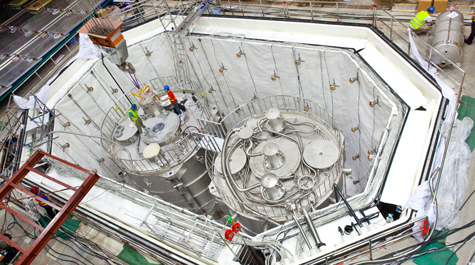William & Mary physics team has role in neutrino experiment
A team of William & Mary physicists has an important role in the Daya Bay Reactor Neutrino Experiment, a multinational collaboration to advance science’s understanding of ubiquitous, yet mysterious, particles known as neutrinos.
Daya Bay in southern China is the site of a large nuclear power plant. Near the power plant, scientists have built a set of mammoth underground apparatus designed to detect the neutrinos emitted from the power plants.
Robert McKeown is Governor's Distinguished CEBAF Professor in William & Mary’s physics department as well as being deputy director for science at the Jefferson Lab. He is leading the William & Mary team that is serving two vital functions at Daya Bay.
Neutrinos are byproducts of nuclear reactions, emitted in near-unimaginable numbers by the sun, by nuclear activity in the core of the earth and by nuclear power plants. Nearly a trillion pass through your body every second.
“The trouble with neutrinos,” McKeown says, “is that they have a weak interaction with matter. In other words, they go through anything.” Odds are that a neutrino can go through a brick of lead a light-year thick without interacting, he said. It’s a quality that makes neutrinos particularly difficult to detect. Daya Bay is designed to increase the odds of detecting neutrinos by placing detectors near the power plants, which produce neutrinos in prodigious numbers as they generate electricity.
The Daya Bay experiment is an attempt to measure an elusive value related to neutrino oscillation. McKeown explains that neutrinos come in three “flavors.” A quality of neutrinos is that they undergo a transformation—or oscillate—from one flavor to another. Two of the oscillation values are known, he said, and the Daya Bay experimenters hope to determine the third and final value, known as θ13. (Pronounced “theta one-three.”)
The value of θ13, McKeown says, will open the way for a new generation of neutrino experiments that will address fundamental questions of nature, such as the relative scarcity of antimatter in the universe. Neutrino study has more immediate practical applications in fields that range from astronomy to nuclear power, including the detection of hidden nuclear reactors.
McKeown is a veteran of KamLAND, a previous neutrino oscillation experiment in Japan. KamLAND targeted neutrinos emitted from Japan’s 54 nuclear power plants, using a detector about 200 kilometers distant. The project was successful, he said, and the team was able to measure the value of an earlier neutrino oscillation, θ12.
KamLAND’s neutrino detection rate was less than one neutrino per day, McKeown said, while the hunt for θ13 requires a much higher rate. McKeown said the answer was a more sensitive set of detectors placed closer to the new, powerful reactors of the China Guangdong Nuclear Power Group.
“There’s an enormous number of neutrinos coming from the reactors. We expect to see something like 800 neutrinos in each detector every day,” he said. “About one every two minutes. That’s a very high rate.”
Before coming to William & Mary and the Jefferson Lab, McKeown led a group at California Institute of Technology that built many important components for the the detectors. His William & Mary group substantial responsibility for the installation, commissioning and calibration of the detection apparatus.
“Since this experiment is so precise, the equipment needs to be calibrated very, very precisely,” he said. Daya Bay has eight detectors and each detector has three units.
“Not only are the detectors deep underground, but they’re also underwater. It’s a complicated set of equipment and a complicated set of data that needs to be analyzed,” he said.
The William & Mary team is also responsible for keeping track of the number of neutrinos being emitted.
“The reactor plant has six reactors. We need to know how many neutrinos are coming from eachreactor,” McKeown said. “The number of neutrinos is directly related to the amount of power generated. It’s not always constant, though.”
Wei Wang, William & Mary research scientist, is at the Daya Bay site overseeing the installation and calibration of the detector equipment. McKeown said much of the team’s work can be done here in the United States, working with data sent from the detectors and the reactor plant.
China and the United States lead the Daya Bay Reactor Neutrino Experiment, which includes participants from Russia, the Czech Republic, Hong Kong, and Taiwan. The Chinese effort is led by project manager Yifang Wang of the Institute of High Energy Physics, and the U.S. effort is led by project manager Bill Edwards of Lawrence Berkeley National Laboratory and chief scientist Steve Kettell of Brookhaven National Laboratory.
 Skip to main content
Skip to main content

